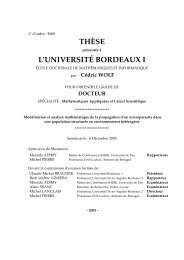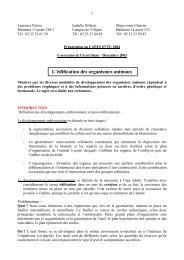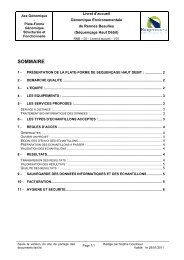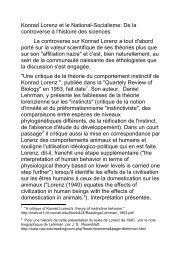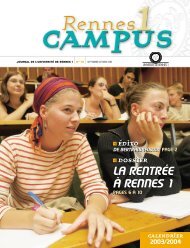1 CHIRONOMUS NEWSLETTER ON CHIRONOMIDAE RESEARCH ...
1 CHIRONOMUS NEWSLETTER ON CHIRONOMIDAE RESEARCH ...
1 CHIRONOMUS NEWSLETTER ON CHIRONOMIDAE RESEARCH ...
You also want an ePaper? Increase the reach of your titles
YUMPU automatically turns print PDFs into web optimized ePapers that Google loves.
different generic combinations is the single<br />
most frequently occurring species epithet.<br />
Although he has collected on every continent<br />
except Antarctica, the one region that stands<br />
above all others with respect to Fittkau’s<br />
attention is the Neotropics, especially the<br />
Amazon and adjacent areas. When Fittkau first<br />
came to South America in 1960 (see Fig. 3) –<br />
on leave from Plön to lead the limnology<br />
department of the Instituto Nacional de<br />
Pesquisas da Amazônia (INPA) in Manaus –<br />
very little was known about chironomids from<br />
that region.<br />
Although several dozen species had been<br />
named in the preceding 150 years, most of<br />
them could not be recognised because their<br />
descriptions were insufficient and their type<br />
specimens lost or useless. From the tropical<br />
Amazon only a handful of species were<br />
known, and this lack of a taxonomic<br />
foundation was particularly dearly felt in light<br />
of the enormous importance and diversity of<br />
these ecosystems. To remedy this situation,<br />
Fittkau spent the following years (1960-1963,<br />
and 1965) to collect a tremendous amount of<br />
material and environmental field data.<br />
Integrating this extensive first-hand experience<br />
with that of others and a wide-ranging<br />
scientific background, he then developed a<br />
comprehensive understanding of the fauna,<br />
functioning, and natural history of these<br />
ecosystems. Based on these insights Fittkau<br />
has tried for the last several decades to alert the<br />
world – from laypeople through science and<br />
academia to politics and international<br />
organisations – to the special beauties, global<br />
value and need for conservation of the Amazon<br />
and tropical ecosystems in general. Inspite of<br />
everything he has been doing for chironomid<br />
research, it is fair to say that he has made those<br />
efforts his most important activity, and the<br />
proportion this topic has assumed in his<br />
publications attests to that (see, e.g., Nos 77,<br />
89, 92, 110, 124, 143).<br />
Fittkau’s work on Neotropical Chironomidae<br />
in particular reflects all of the means<br />
highlighted in the preceding paragraphs, with<br />
which he has enhanced research and<br />
knowledge on these organisms and their roles<br />
in nature. True to his principle of<br />
collaboration, he sought from the beginning to<br />
find, win over or train fellow workers,<br />
especially from South America, and has<br />
generously aided and supported everybody<br />
willing to share in the necessary tasks. For<br />
example, early on he joined forces with<br />
Sebastião José de Oliveira, the first Brazilian<br />
researcher to study chironomids independently,<br />
and the two friends are still enjoying this most<br />
long-standing of partnerships (Fig. 4).<br />
Fig. 4. S. J. de Oliveira and E. J. Fittkau at the<br />
International Symposium in Rio de Janeiro,<br />
2000<br />
As the result of this collective effort coinitiated<br />
and promoted by Fittkau, our<br />
knowledge of the Neotropical chironomid<br />
fauna has greatly increased e.g., the number of<br />
described species is now close to 800 (author’s<br />
unpublished data) – and continues to grow<br />
faster at this time than in any comparable<br />
world region, in large part due to the<br />
contributions from a very active and hopefully<br />
still growing contingent of workers in South<br />
America itself. The entire history and<br />
development of research on Neotropical<br />
Chironomidae have been lucidly recounted<br />
recently by Fittkau himself (2001c, No.157;<br />
see also No. 160).<br />
Looking in detail at Fittkau’s publications<br />
specifically on chironomid topics, we again<br />
find numerous most significant contributions<br />
to the field. These works range from diagnostic<br />
descriptions of single taxa through revisions on<br />
various classification levels (e.g. Nos 15, 36,<br />
40, 47, 140) to phylogenetic and comparative<br />
examinations of morphological features (e.g.<br />
Nos 13, 18, 39), and to faunistic and<br />
zoogeographical overviews (e.g. Nos 23+65,<br />
69, 70, 102).<br />
On the desciptive level, Fittkau is the<br />
taxonomic author or coauthor of 3 tribes,<br />
almost 30 genera, and nearly 100 species –<br />
mostly in the Tanypodinae, but also in several<br />
other subfamilies. Many of his new taxa have<br />
widened our view of just how diverse and<br />
exotic chironomid morphology and biology<br />
can be (e.g. Nos 7, 16, 27, 54). From his<br />
earliest works to this day, Fittkau’s<br />
descriptions always impress by his eye for<br />
5



